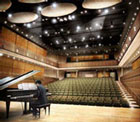 |  |
|
|
 First
the good news. Zankel Hall's visuals are pleasant and bright. Its shoebox
shape is considered acoustically desirable - to judge by such legendary
spaces as the Vienna Philharmonic's Musikvereinssaal and the marvellous
Music Room at La Chaux-de-Fonds, Switzerland. Zankel's blond sycamore and
maple interior is reminiscent of Tanglewood's Ozawa Hall. The air conditioning
is strong and the green-upholstered seats are comfortable. Acoustically
the space is a bit dry for solo vocal recitals, string quartets, and chamber
music concerts, but it seems good for piano recitals, larger bands and anything
amplified. First
the good news. Zankel Hall's visuals are pleasant and bright. Its shoebox
shape is considered acoustically desirable - to judge by such legendary
spaces as the Vienna Philharmonic's Musikvereinssaal and the marvellous
Music Room at La Chaux-de-Fonds, Switzerland. Zankel's blond sycamore and
maple interior is reminiscent of Tanglewood's Ozawa Hall. The air conditioning
is strong and the green-upholstered seats are comfortable. Acoustically
the space is a bit dry for solo vocal recitals, string quartets, and chamber
music concerts, but it seems good for piano recitals, larger bands and anything
amplified.Unfortunately, Zankel Hall's visual splendor and comfort is compromised by subway noise. Every two minutes the N and R trains thunder through the 57th Street station, just yards away from patron seating through a thin layer of bedrock. About half of Zankel's programming is seriously hurt by the subway noise. Amplified pop, folk, and world music has nothing to fear. But Carnegie's traditional classical fare -- such as solo vocal and instrumental recitals and chamber music -- is seriously disrupted by the subway. Senegalese pop star Youssou N'Dour's concert of amplified voice, guitar and drum (heard Sept. 16, 2003) was loud enough to completely cover the subway noise. He rocked the house, and a good time was had by all. But during a concert of Handel and Bach by German countertenor Andreas Scholl and the Orchestra of St. Luke's (heard Sept. 19, 2003), the subway's rumbling made it impossible to focus on details or to get into the mood of the music. Audience members grumbled and even the musicians seemed unnerved. The unwanted Sensurround problem was also annoying during the concert by Pierre Boulez and the Ensemble Intercontemporain (heard Sept. 17). Critics have signalled their displeasure with the subway noise. The New Yorker wrote, "The subway is distinctly audible as it rumbles behind the right wall. I tried and failed to dismiss the noise as a minor annoyance; it kept intruding on my consciousness." The Financial Times lamented "acoustic inequity." The Wall Street Journal wrote that Zankel was "compromised by the rumble of nearby subways." Perversely, the Los Angeles Times suggested that the subway noise was "beautiful" and urged its readers to "imagine how much such a sound effect would cost if you had to pay for it." Andante.com mindlessly burbled that "New Yorkers are accustomed to sirens and other noise [...] The occasional cool whoosh of the nearby subway [...] shouldn't be a big deal." Serious music lovers can only marvel at such glib opinions. Fortunately Carnegie Hall has acknowledged the problem. Acoustician Christopher Jaffe admitted to the Wall Street Journal that "There's still work to be done." Carnegie boss Robert Harth stated that a consultant has been engaged "to make recommendations [...] about further possible mitigation measures." Let's hope that the city-owned Carnegie Hall and the Metropolitan Transit Authority can quickly agree on measures to eliminate subway noise in Zankel Hall (for example, insulating the 57th Street N/R station and re-laying the subway rails on acoustically absorbent buffers). We must not forget that classical music is about hearing sound in its most pristine form. Carnegie Hall owes its artists, audience, and itself no less.
| |
|